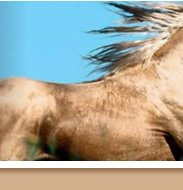![]()
![]()
![]()
![]()
![]()
![]()

![]()
![]()
![]()
![]()
![]()
EQUUS Consultants: Lowering the Risk LongeingMedical editor Matthew Mackay-Smith discusses ways to reduce longeing-related injuries. Question: I would like to longe my 6-year-old mare with side reins, but I am concerned about wear on her knee joints. I keep all of my horses until they go to the big green pasture in the sky, so I'm hoping to keep her sound for another 25 years or so. What steps can I take to make sure longing is as easy on her knees as possible and is there any arena depth that would be optimum? Answer: The constraints of time and space most of us face make circular exercise for horses an appealing compromise. Longeing a horse for educational purposes and exercise can be useful with progressive planning and preparation so long as it is conducted in a safe and sane way. In terms of training, the risks of longeing include reinforcing several undesirable behaviors including unruliness/willfulness due to poor control, the tendency to either balk or run away or both, and even dangerous aggression toward the person at the center of the circle. Physical risks for the horse arise mainly from excessive twisting (torque) of the limbs around their long axes, due to speed, centrifugal force and inadequate slope (banking) of the work surface. So the danger is really strains, rather than wear and tear. You can reduce a horse's chances of developing a strain by longeing in the correct environment. A longe area needs to be level and uniform, with a perimeter built from fairly deep sand that yields to the hoof enough to encourage the bottom of the foot to stay perpendicular to the leg. Four to six inches of sand will usually suffice. With use, the longeing surface becomes progressively sloped inward as the sand is pushed out. Resist the urge to drag the track flat, because the berm created becomes a banked rim on which longeing at the walk, trot and collected canter or lope can be done safely. Clearly, the larger the circle, the less torque on the legs and the smaller the circle, the better your control. Most people compromise by longing horses on a circle between 40 and 60 feet in diameter. A fence or another barrier around the outside adds to control, and accommodates free-longeing and other educational drills and exercises. |
![]()
![]()
ęCopyright 2024
Alhaja.net All rights reserved.
Unauthorized duplication in part or whole strictly prohibited by
international copyright law.
![]()



